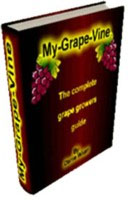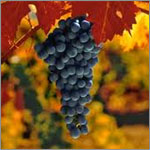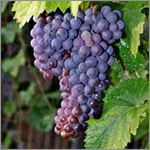Barbera |
|
This is a popular Italian grape variety, and is known for its high yielding capabilities, deep color and lower level of tannins. It is thought to have originated around the 13th century near Piedmont, Italy. Australia, Argentina and California are the most notable regions for this grape outside of Italy. When the wines are young, they offer an intense aroma of fresh red and blackberries, while in the lighter versions, notes of cherries, raspberries and blueberries will be found. In wines made from riper grapes, notes of blackberry and black cherries are evident. |
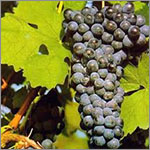 |
Cabernet Franc |
|
Cabernet Franc is mainly grown for blending with Cabernet Sauvignon and Merlot, especially in Bordeaux. This is a major grape variety grown in many regions of the world, and it makes a light style of red wine when made on its own. It is similar to Cabernet Sauvignon in many ways, except it ripens a few weeks earlier, which allows it to thrive in cooler climates, such as in the Loire Valley. The wines are slightly less pigmented, but still have a similar richness with a pronounced perfume and hints of blackcurrants, raspberries and violets. Many boutique wineries in South Africa have embraced the variety, while in Chile and Argentina, acreages are increasing all the time. |
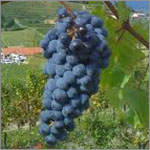 |
Cabernet Sauvignon |
|
This variety is the king of kings when it comes to red wines. As the most recognized of red grape varieties, it is grown in all major wine producing countries in the world, even in some whose climate may not seem at first to be ideal, such as Canada. The variety is a cross between two popular varieties, Cabernet Franc and Sauvignon Blanc. It is a very hardy vine, and the grapes are resistant to frost and rot due to their thick skins. In Bordeaux, Cabernet Sauvignon is frequently blended with Cabernet Franc and Merlot, and sometimes Malbec, whereas in most other countries, the wine is made just as a single variety. The use of oak, either during fermentation or for aging in barrels, is widely carried out, and allows the wine to develop unique vanilla wood flavors to complement the blackcurrant flavors within the grape. |
|
Gamay |
|
The Gamay grape is thought to have got its name from a hamlet belonging to the village of Saint-Aubine, near Puligny-Montrachet. Its most notable growing region is in Beaujolais as well as in the Loire Valley, it is also the grape of the Beaujolais nouveau. It's quite a heavy-cropping variety with grape bunches more or less tightly-packed according to variety. The variety which concerns us is the white-juiced black Gamay which, growing on the granite soils of the Beaujolais hills, produces attractive, delicate and aromatic red wines (though on the clay-limestone soils of the Câte d'Or it yields only rougher wines). The red wines of the Mâconnais and Beaujolais owe their reputation to this plant. |
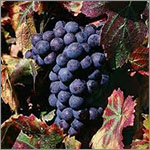 |
Grenache |
|
Thought to have originated in northern Spain, Grenache is another extremely widely planted red grape variety all over the world. Due to its late ripening, it needs hot, dry conditions to flourish, as those in Spain and the south of France. In the United States, the variety found favor in the early days of the Californian wine industry. Australia also has considerable plantings of this high yielding grape. With such high natural sugar levels, Grenache is often used in fortified wines, such as Banyuls in France, and also in Australia. As it is prone to be lacking in adequate acidity, color and tannin, the variety is normally used in blendings, with varieties likes, Syrah, Cinsault and Tempranillo. Due to its lower acids and soft structure, the the grape has a tendency to oxidize during winemaking. |
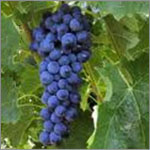 |
Malbec |
|
Malbec grapes are inky dark in color with robust tannins, and are permitted to be used in Bordeaux blends. Growers in Argentina are consistently valuing this variety very highly, as they are achieving success with their own wines. Chile is also keen on the Malbec grape outside of France. Being a thin-skinned grape and needing more sunshine and heat than either Cabernet Sauvignon or Merlot to mature. It ripens well and can be very deep in color with plenty of tannin, and a certain plum-like flavor to claret blends. Jancis Robinson, describes Malbec as a '"rustic" version of Merlot. Believe it or not, a perfume based on extracted alcohol from Malbec grapes is now being made in Brazil. |
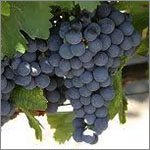 |
Merlot |
|
Merlot is a dark blue-colored wine grape, that is used as both a blending grape and for varietal wines. Any wines with Merlot in their blend tend to have a medium body with hints of berry, plum, and currant. Its softness combined with earlier ripening, makes this grape variety a popular choice for blending with the later-ripening, harsher Cabernet Sauvignon, which tends to be higher in tannin. Popular all over the world, it is the most common variety in France, grown widely in Argentina, Chile, New Zealand, Australia and South Africa. On its own Merlot can make soft, velvety wines with plum flavors. However, other styles with lower tannins or a higher tannic structure, similar to Cabernet Sauvignon are also made. There are so many fruit notes associated with Merlot all depending on how it was made. It's an extremely popular all-round red wine for easy drinking. |
|
Nebbiolo |
|
This is another great Italian variety associated with the Piedmont region, where Barolo and Barbaresco wines are made from it, This variety is very susceptible to coulure (berry drop) if the weather is too wet during the bud burst and flowering periods. Nebbiolo wines tend to be lighter red in color, but can be higher in tannin, especially when young. With the advent of stainless steel winemaking vats with temperature control, it is easier to ensure the fermentation is slow and controlled, keeping all the delicate flavors in the wine. Subsequent hygiene is also easier to avoid bacterial spoilage. Wines benefit from oak aging to help soften the tannins, and in order to reduce the acidity, the wine benefits from being put through a malolactic fermentation. |
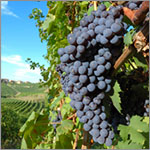 |
Pinotage |
|
Pinotage (a cross between Pinot Noir and Cinsault) is the red grape variety made famous in South Africa. Kanonkop Estate under the winemaker, Beyers Truter has championed this variety and they have won numerous awards for the quality of their Pinotage wines. There are small plantings in New Zealand and the United States, but this variety has not fallen into favor in other countries. This is perhaps because it bears no resemblance in character or flavor to either of its French parents. Wines made from this variety have not always proved popular, as isoamyl acetate can develop during winemaking giving the wine a pungent smell reminiscent of paint. |
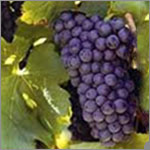 |
Pinot Noir |
|
Associated with Burgundy, Pinot Noir has to be one of the most interesting of all grape varieties. It produces some of the best wines in the world, but is notoriously difficult to grow and make into wine, it's that challenge that winemakers love! It is an important variety as it is used with Chardonnay and Pinot Meunier to make Champagne. Pinot Noir used as a still wine usually produces a rosé wine with a gentle pink coloration, and it can be made as a straight forward white wine. It is grown worldwide, and even in the UK as part of the blend for sparkling wine. In Germany the variety is called Spätburgunder (ie. "Late Burgundian"), and is now the most widely planted red grape. It shows how important the grape is when Master Sommelier, Madeline Triffon calls the variety "sex in a glass". |
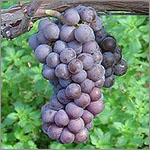 |
Sangiovese |
|
This Italian red wine grape variety gets its name from the Latin sanguis Jovis, which means "blood of Jove". and it's thought that Sangiovese may have been known by Etruscan winemakers in the late 16th century. It is probably indigenous to Tuscany, whose most famous wine is Chianti. The variety adapts to a wide range of soil types, but thrives extremely well in highly concentrated limestone soils. In the Chianti Classico region the soils are made up of friable shale-clay. Both of these soil types produce higher quality grapes than those grown on clay based ones. Outside of Italy, the grape is popular in Argentina, Romania, France, California and Australia. In Italy, it is the most widely planted red grape variety. Winemaking can be problematic due to the higher acidity and lighter body that the variety has. Methods have been devised to try and extract as much flavor and character from the grapes, including fermentation temperature adjustments and the use of oak treatments. |
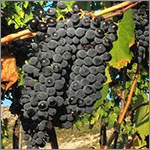 |
Shiraz / Syrah |
|
Syrah was made famous by the wines produced from Hermitage in the northern Rhône. For centuries, wines made at Hermitage had an excellent reputation for being powerful and of good quality. In the late 1800's, Syrah became well established in Australia, having been brought there by Scotsman, James Busby around 1831 - he is regarded as 'the father of Australian viticulture'. Also grown in most major winegrowing countries. Here we have a variety that is renowned for producing powerful red wines the world over. It is unquestionably Australia's highest profile wine, and perhaps its best. Sometimes it is used in a blend with either Voignier, Cabernet Sauvignon or Grenache, otherwise it's made as a single varietal wine. The wine is full-bodied with a wide range of flavors, depending on the soil and climate, as well as various viticultural practices. Notable aromas are of blackberry and pepper, and sometimes of chocolate and even violets. Secondary flavors are dependent on the winemakers practices, such as, yeast and oak treatments. |
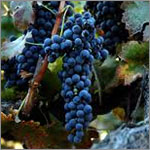 |
Tempranillo |
|
Native to Spain, Tempranillo makes full-bodied red wines from thick-skinned grapes grown at high altitudes in warm climates. In Portugal, the variety is nearly always blended with others to make port wine. As Oz Clarke notes:
Tempranillo wines are ruby red in colour, while aromas and flavors can include berries, plum, vanilla, herb and even leather and tobacco. But as the variety tends to have lower sugars and acids, it is usually blended with Grenache, Merlot or Cabernet Sauvignon. |
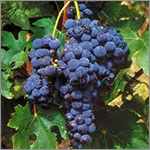 |
Zinfandel |
|
This variety is planted in California, Italy and on the Dalmatian coast of Croatia. The vines are fairly vigorous and grow best in warm rather than hot climates, because grapes can shrivel in hot weather. Zinfandel's thin-skinned grapes grow in large, tight bunches that are sometimes prone to botrytis cinerea. The variety is known for its unevenness of ripening, where some of the berries are fully ripe while others are still green and totally unripe. The grapes are high in sugar, and in years when the weather is kind, late harvesting can take place and dessert wines made. In the United States, the grapes normally produce robust red wines, although a blush-style, semi-sweet rosé wine, called White Zinfandel has proved more popular selling six times more than the red wine. |

